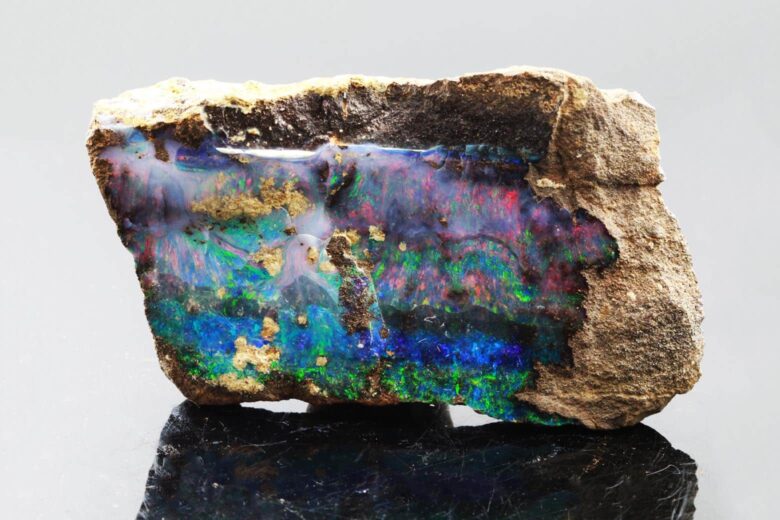The value of an opal stone can vary greatly depending on several factors such as size, color, clarity, origin, and the type of opal.
Black opals, which have a dark background and bright color play, are the most valuable type of opal and can sell for hundreds or even thousands of dollars per carat.
White opals, which have a lighter background and more muted color play, are less valuable and typically sell for less than $100 per carat.
Fire opals, which are transparent to translucent and have bright orange to red body color, are also valued for their unique color and can sell for $50 to $500 per carat.
Boulder opals, which have an ironstone matrix and are often cut and polished to showcase both the matrix and the opal, are valued for their unique patterns and can sell for $100 to $500 per carat.
Finally, the origin of an opal also plays a role in its value. Opals from Australia, the world’s largest producer of opals, are the most sought-after and can sell for a premium compared to opals from other countries.
It is important to note that the value of opal can also be influenced by factors such as the rarity of its color play, the size and shape of the stone, and the quality of its cut and polish.
In summary, the value of opal can range from a few dollars per carat to tens of thousands of dollars per carat, depending on its type, origin, and quality.
How to value opal gemstones?
Valuing an opal gemstone is a complex process that takes into account several factors, including the type of opal, its origin, size, color, clarity, cut, and market demand. Here is a closer look at the key factors that influence the value of an opal gemstone:
- Type of Opal: The type of opal plays a significant role in determining its value. The most valuable opals are black opals, which have a dark background and bright color play, while white opals, which have a lighter background and more muted color play, are less valuable. Fire opals, which are transparent to translucent and have bright orange to red body colors, are also valued for their unique color. Boulder opals, which have an ironstone matrix, are valued for their unique patterns.
- Origin: The origin of the opal can also impact its value. Opals from Australia, the world’s largest producer of opals, are the most sought-after and can sell for a premium compared to opals from other countries.
- Size: The size of an opal also affects its value. Larger opals are generally more valuable, but the value per carat can decrease with increasing size due to a decrease in the intensity of color play.
- Color: The color play of opal is one of the most important factors in determining its value. Opals with bright, vibrant colors are more valuable than those with dull or faded colors. The body color of the opal, or the background color of the stone, also plays a role in its value, with black being the most valuable and white being the least.
- Clarity: The clarity of opal can also impact its value. Opals with inclusions, cracks, or other internal flaws are generally less valuable than those with high clarity.
- Cut: The cut of an opal can affect its value, as a well-cut stone will showcase its best features and maximize the color play. A poorly cut stone can hide its best qualities and decrease its value.
- Market Demand: The demand for opals in the market can also impact their value. If demand is high, the price of opals may increase, while a decrease in demand can result in a decrease in price.
Also read:- write for us tech
Also read:- Technology write for us
Also read:- write for us technology blogs
When valuing an opal gemstone, it is important to consider all of these factors and to have a thorough understanding of the market. A professional gemologist or appraiser can provide a more accurate estimate of an opal’s value by examining the stone in person and taking into account its unique qualities.
Also read: Know Your Birthstone: According to Your Zodiac Sign
In conclusion, the value of an opal gemstone is influenced by several factors, including its type, origin, size, color, clarity, cut, and market demand. By considering these factors, it is possible to determine the approximate value of opal and make informed decisions when buying or selling this unique and beautiful gemstone.
How to check Opal stone defects?
Checking for defects in an opal stone is an important part of determining its quality and value. Defects can reduce the overall appearance and durability of the stone and can impact its value. Here are some steps to check for defects in an opal stone:
- Visual Inspection: The first step in checking for defects in opal is to perform a visual inspection. Look for cracks, inclusions, or other internal flaws that can impact the stone’s appearance and durability. Check for any signs of discoloration or fading in the color play, which can indicate that the stone has been exposed to excessive heat or light.
- Magnification: To get a closer look at the stone, use a magnifying glass or a loupe, which is a small magnifying tool used by jewelers. This will allow you to examine the stone in greater detail and identify any small cracks, inclusions, or other defects that may not be visible to the naked eye.
- UV Light: Another effective way to check for defects in opal is to examine the stone under ultraviolet (UV) light. Opals have the unique property of fluorescing, or glowing, under UV light, and this can highlight any cracks or inclusions in the stone. If the opal fluoresces evenly and brightly under UV light, it is likely to be of high quality. If there are areas of the stone that do not fluoresce or if the fluorescence is uneven, this may indicate the presence of cracks or other defects.
- Dye Test: To check for cracks in an opal, you can perform a dye test. Place a drop of dark-colored dye on the surface of the stone and allow it to soak in. If there are any cracks in the stone, the dye will penetrate them and become visible.
- Immersion Test: To check for inclusions in an opal, you can perform an immersion test. Fill a container with water and place the opal in the water. If there are any inclusions in the stone, they will be visible as bubbles trapped inside the stone.
It is important to note that some defects in opal stones are natural and may not have a significant impact on the stone’s quality or value. However, excessive cracking, inclusions, or other internal flaws can reduce the durability and overall appearance of the stone, and can impact its value.
In conclusion, checking for defects in an opal stone is an important part of determining its quality and value. Visual inspection, magnification, UV light, dye tests, and immersion tests are all effective ways to identify defects in opal and to determine its overall quality and value. If you are in doubt about the quality of opal, it is recommended to consult with a professional gemologist or appraiser for a more accurate assessment.
Factors determining the price of opal silver jewelry?
The price of opal silver jewelry is determined by a number of factors, including the quality of the opal, the design and craftsmanship of the jewelry, and the weight and purity of the silver used. Here are some of the key factors that determine the price of opal silver jewelry:
- Quality of the Opal: The quality of the opal is the most important factor that determines the price of opal silver jewelry. The most highly valued opals are those with a bright, vibrant color play, a high degree of transparency, and few cracks or inclusions. The size and shape of the opal also play a role in determining its value, with larger, symmetrical stones generally being more highly valued than smaller, irregularly shaped stones.
- Design and Craftsmanship: The design and craftsmanship of the jewelry are also important factors that determine its price. A well-designed piece of jewelry, with intricate details and a high degree of craftsmanship, will generally be more expensive than a simple, mass-produced piece.
- Weight and Purity of Silver: The weight and purity of the silver used in the jewelry also play a role in determining its price. Silver is priced by weight, and the heavier the silver, the more expensive the jewelry will be. The purity of the silver is also important, with 925 sterling silver being the most commonly used and highly valued.
- Brand and Reputation: The brand and reputation of the jewelry designer or manufacturer can also impact the price of opal silver jewelry. Well-established and highly regarded jewelry designers and manufacturers will generally charge more for their products, as their reputation for quality and craftsmanship is reflected in the price.
- Location and Availability: The location of the seller and the availability of the jewelry can also impact its price. Jewelry that is sold in upscale jewelry stores or in exclusive shopping districts is likely to be more expensive than jewelry sold in discount or chain stores. The availability of the jewelry can also impact its price, with rare or limited-edition pieces generally being more expensive.
In conclusion, the price of opal silver jewelry is determined by a combination of factors, including the quality of the opal, the design and craftsmanship of the jewelry, the weight and purity of the silver used, the brand and reputation of the jewelry designer or manufacturer, and the location and availability of the jewelry. By considering these factors and doing some research, you can make an informed decision about which opal silver jewelry is right for you and your budget.
Author bio:
Hello, I am a professional SEO Expert & Write for us Technology blog and submit a guest posts on different platforms- we provides a good opportunity for content writers to submit guest posts on our website. We frequently highlight and tend to showcase guests.



